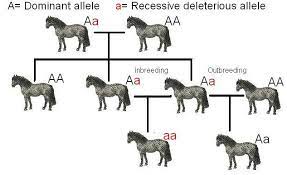HETEROSIS AND INBREEDING DEPRESSION
- Heterosis or hybrid vigor is the increased function (productivity or superiority) such as size, growth rate, fertility, and yield in a hybrid offspring.
- Heterosis can be the result of the masking of deleterious recessives by dominant or partially dominant alleles, result in a hybrid with different collection of favorable dominants.
- It is also called outbreeding enhancement.
- H. Shull coined the word heterosis.
- An offspring is said to be heterotic if superiority of F1 hybrid is over both the parents in terms of yield and some other biological characters. These effects can be due to Mendelian or non-Mendelian inheritance.

Heterosis and Inbreeding Depression
- Inbreeding depression occurs when related parents have children with traits that negatively influence their fitness largely due to homozygosity. In such cases, outcrossing should result in heterosis. However, not all outcrosses result in heterosis.
- Inbreeding depression is the loss of fitness due to loss of genetic diversity. Inbred strains tend to be homozygous for recessive alleles that are mildly harmful or say produce an undesirable from the standpoint of the breeder. Whereas, Heterosis or hybrid vigor is the tendency of outbred strains to exceed both inbred parents in fitness.
- So the key difference between heterosis and inbreeding depression is that heterosis is the enhancement of traits due to the mixing of genes from two different individuals during outbreeding; while, inbreeding depression is the reduced biological fitness of offspring due to the increased homozygosity as a result of inbreeding between closely related individuals.
Dominance Hypothesis & Overdominance Hypothesis
- In most situations the two hypotheses, dominance and overdominance, are similar as inbreeding leads to loss in vigor and reduction in productivity, whereas out-crossing lead to recovery in vigor and fertility. The degree of heterosis would depend upon the genetic diversity of the parents.
- Dominance hypothesis was first expressed in 1908 by the geneticist Charles Davenport. It refers to the superiority of hybrids to the suppression of undesirable recessive alleles from one parent by dominant alleles from the other.
- According to dominance hypothesis, heterosis results due to masking effects of dominant desirable alleles over harmful recessive alleles. A genotype with more dominant alleles would be more vigorous than one with a few dominant alleles
- Overdominance hypothesis was developed independently by Edward M. East and George Shull (1908).
- According to overdominance hypothesis, heterozygote is superior to either of the homozygotes and heterosis results due to complementation between divergent alleles of a gene. A genotype with more heterozygous loci would be more vigorous than one with less heterozygous loci for a particular quantitative trait.
Controversy
Particularly in selective breeding of domestic animals, it is sometimes claimed that all crossbred plants and animals are “genetically superior” to their parents, due to heterosis. Hence, causes confusion and even controversy about the term heterosis.